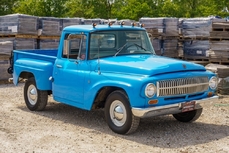Volkswagen Typ 2 (post 1967) Bulli 2.0L four-cylinder 1978
Allgemeine Beschreibung :
1978 Volkswagen Type 2 Bus Westfalia Camper
The Type 2 VW Vans remain an iconic historic figure today
Extremely correct and unmolested Westfalia Camper from Colorado
Correct Sage Green exterior (code L63H) with white roof and trim
Correct Camping Green Yellow plaid fabric interior (code 34) with black dashboard with factory VDO gauges
Westfalia fiberglass top and pop-up canvas are fully functional
Westfalia Deluxe Edition amenities include a sink with 7 gallon water tank and icebox
Hard to find original fold-out center front table
1970cc flat-four engine and four-speed manual transmission
Original-spec Bosch L-Jetronic fuel injection has been retained
Hella headlights and spare tire on nose with cover
Solid original floors and factory green painted wheel wells as seen in the accompanying photos
Own this Vehicle from $539 per month-call 636-600-4600
The Volkswagen Bus convoy keeps rolling here at MotoeXotica Classic Cars. Our latest arrival our of Colorado is a very correct and unmolested Sage Green 1978 Volkswagen Bush with the Westfalia Camper option. This example was produced in June 1978. The Westfalia-Werke Van Conversion Company converted the Type 2 VW Vans in to these awesome campers. Volkswagen described the Campmobile as “having a cottage that goes anywhere you want to go”. These icons are still nostalgic head turners today with a lot of fans whenever they head down the road or pull in to a campground.
Everyone loves a Westfalia. It makes people smile and dream, more than any other camper can, and its resale value is bulletproof. There aren’t many cars left that deliver this kind of freedom. Besides, any car, no matter how bad it is, that instantly makes you happy and stress-free behind the wheel; a car that makes you realize that all the tiny, insignificant worries of your stressful life are nothing more than cosmic dust is worth every penny.
Dressed in Sage Green (code L63H) with white roof and accents, this late bay’s paint and trim are in overall excellent condition. The glass is clear and intact, while the van’s lights are in similar condition, including its Hella headlights. The Loaf’s bodywork is straight , its engine bay is tidy and still retains a lot of original factory paint. The bumpers are in excellent order and handsomely match the wheels.
This bus rolls on BFGoodrich Precept Touring radials, 205/70R14 at all four corners. Each tire wraps around a white factory steel wheel topped with a chrome VW center caps. The tires and wheels are in very good order.
Out back is the correct 1970cc flat-four engine that still retains its original-spec Bosch L-Jetronic fuel injection, and which featured hydraulic valve lifters, eliminating the need to periodically adjust the valve clearances as on earlier models. Nineteen seventy-eight was the first year for electronic ignition, utilizing a hall effect sensor and digital controller, eliminating maintenance-requiring contact-breaker points. As with all Transporter engines, the focus in development was not on power, but on low-end torque. The Type 4 engines were reportedly more robust and durable than the Type 1 engines, particularly in Transporter service. Buttoned to this motor is a four-speed manual transmission. This late bay has front disc and rear drum brakes. Underneath the bus you will find solid original floors and factory green painted wheel wells as seen in the accompanying photos
Inside, the upholstery is done Camping Green Yellow Plaid (code 34). The high-backed front buckets are in excellent shape, as is the green carpeting. The headliner is better-than-average and the original, two-spoke factory steering wheel looks great. The inner door panels are in good order, while the instrument pane is in very good shape, complete with its VDO gauges. In back, there’s a factory refrigerator, and sink along with extra seating and storage. Pull the carpet up and you will be very happy to see original factory green painted sheet metal in great condition!
Campmobile features on this Westy include: Rear bench seat converting to double bed with locker below, swivel seat, clothes closet with vanity mirror, ceiling cabinet, linen closet, 12 volt ceiling lamp, 110-125volt AC electrical hook up receptacle, double outlets, master switch and circuit breaker, louvered windows, cabinate with stainless steel sink, 12v water pump, 7 gallon water tank, icebox, curtains, insulated paneled walls, fiberglass pop-up top, weather resistant canvas sides, screened window zipper flap, double bed mattress, front mounted spare tire, outside water hook up and tartan plaid interior upholstery.
Competition to this Loaf in 1978 included Chevrolet’s G10 Van, Dodge’s B-Series Ram Van, Ford’s Econoline Van and GMC’s VanDura.
Volkswagen fans who seek a different sort of T2 should check out this model out, as should anyone who’s looking for a rolling camper to use this fall at their lake house, to head south this winter to their favorite camping getaway or for just an overnight trip to the woods. Stop by MotoeXotica Classic Cars and check this Westie out soon.
This car is currently located at our facility in St. Louis, Missouri. Current mileage on the odometer shows 78,937 miles. It is sold as is, where is, on a clean and clear, mileage exempt title. GET OUT AND DRIVE!!!
Please Click Here to View Our YOUTUBE Video!
Copy & Paste the Link Below to View Our YouTube Video:
https://youtu.be/YtNASTTei6M
VIN: 2382133871
https://www.motoexotica.com/inventory/listing/1978-volkswagen-westfalia-2/
1978 Volkswagen Typ 2 (post 1967) Bulli 2.0L four-cylinder is listed verkauft on ClassicDigest in Fenton (St. Louis) by for $39900.
Fakten der Auto
Karosserietyp : Auto Marke : Volkswagen Modell : Typ 2 (post 1967) Bulli Ausführung : 2.0L four-cylinder Hubraum : 2.0 Modelljahr : 1978 Karosstyp : Lieferwagen Lage : Fenton (St. Louis)
Verkauft
Angaben Zum Verkäufer
Verkauft
People who viewed this Volkswagen Typ 2 (post 1967) Bulli also viewed similar Volkswagen listed at ClassicDigest
Other cars listed for sale by this dealer
über Volkswagen
Die Volkswagen-Geschichte ist in der Tat eine faszinierende Geschichte von Innovation, Belastbarkeit und Wiederbelebung nach dem Krieg, die von verschiedenen Modellen gekennzeichnet ist, die in der Automobilgeschichte zu Ikone geworden sind.Das Volksauto (Volkswagen): Zunächst von Adolf Hitler in den 1930er Jahren als "Volksauto" oder "Volkswagen" auf Deutsch vorgestellt, war die Idee, ein erschwingliches und praktisches Fahrzeug für das deutsche Volk zu schaffen. Dieses Konzept führte zur Entwicklung des von Ferdinand Porsche entworfenen Volkswagenkäfers (oder des Typ 1).
Nachkriegsherausforderungen: Nach dem Zweiten Weltkrieg stand Volkswagen erhebliche Herausforderungen. Die Fabrik war stark beschädigt, und die Verbindung der Marke mit dem NS -Regime führte in einigen Regionen zu einem mangelnden Interesse an dem Auto.
Britische Intervention - Die britische Armee & Ivan Hirst: Die britische Armee übernahm die Kontrolle über die Fabrik in der unmittelbaren Nachkriegszeit. Major Ivan Hirst, ein Offizier der britischen Armee, spielte eine entscheidende Rolle bei der Wiederbelebung von Volkswagen. Er erkannte das Potenzial des Käfers und setzte sich für seine Produktion ein. Er überzeugte das britische Militär, mehrere tausend Autos zu bestellen. Diese Entscheidung hat dazu beigetragen, die Wiederbelebung der Marke zu starten.
Exporterfolg und der globale Anziehungskraft des Käfers: Der Käfer gewann nicht nur in Deutschland, sondern auch weltweit an Popularität und wurde zu einer Ikone des erschwinglichen Fahrwerks. Das einfache, zuverlässige Design und das einzigartige Erscheinungsbild machten es zu einem Favoriten unter den Verbrauchern weltweit.
Modellentwicklung: Im Laufe der Jahre führte Volkswagen verschiedene Modelle neben dem Käfer ein, wobei jeder zum Wachstum der Marke beitrug:
Typ 2 (VW -Bus oder Transporter): In den 1950er Jahren wurde er in den 1960er Jahren zu einem ikonischen Symbol der Hippie -Bewegung eingeführt und wurde wegen seiner Geräumigkeit und Vielseitigkeit geliebt.
Golf (Kaninchen in den USA): Der Golf (oder Kaninchen in den USA) wurde Mitte der 1970er Jahre ins Leben gerufen und markierte eine Verlagerung in Richtung Frontantrieb, modernes Design und Schrägheckpraktikabilität und wurde zu einem Eckpfeiler des Erfolgs der Marke.
Passat, Jetta und andere Modelle: Volkswagen erweiterte seine Aufstellung mit Modellen wie dem Passat und Jetta, die sich für verschiedene Marktsegmente befassen.
Herausforderungen und Innovationen: Trotz des Erfolgs stand Volkswagen vor Herausforderungen, einschließlich Qualitätsproblemen in den 1970er Jahren. Die Marke hat jedoch weiterhin neue Modelle und Technologien entwickelt und entwickelt.
Aufstieg des GTI und globaler Expansion: In den 1980er Jahren stieg der legendäre Golf GTI auf, eine Hochleistungsversion, die den Trend der heißen Luke auslöste. Volkswagen erweiterte auch seine globale Präsenz in diesem Zeitraum.
Die britische Intervention bei der Wiederbelebung von Volkswagen nach dem Zweiten Weltkrieg spielte eine entscheidende Rolle bei der Wiederbelebung der Marke. Während es in den 1950er und 1960er Jahren aufgrund des Erfolgs von Volkswagen in den 1950er und 1960er Jahren möglicherweise einige Spannungen oder einen Wettbewerb zwischen Automobilunternehmen gegeben hat, hat die Fähigkeit der Marke, innovative und beliebte Modelle zu produzieren, ihren Platz in der Automobilgeschichte festigend.






